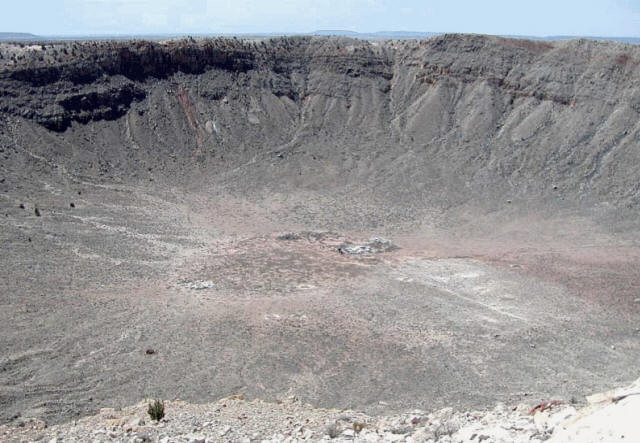Craters and Buttes Part One
Nov
30, 2009
Craters often have flat bottoms
and forty-five degree slopes. Buttes
often exhibit forty-five degree
shoulders and flat tops.
It would seem to be inevitable that
craters are formed when an object
strikes some other solid surface and
explodes, blasting material up and
out, leaving a somewhat conical
hole. That is the accepted
explanation for locations such as
Meteor Crater.
Consensus opinions state that
Meteor Crater was formed when a
chunk of nickel-iron approximately
50 meters in diameter, weighing
300,000 tons, slammed into the
Arizona desert at a speed of 12
kilometers per second. The object is
thought to have
detonated with a force
equal to 2.5 megatons—almost as
large as early hydrogen bomb tests
conducted in the Pacific.
Previous Picture of the Day
articles have indicated, however,
that there are several anomalous
features associated with craters on
Earth, as well as on other celestial
bodies. In the case of Meteor
Crater, the 300,000 tons of
nickel-iron has vanished. Despite
years of extensive drilling and
exploration, all that could be
retrieved was a handful of tiny
iron spherules scattered
throughout the surrounding terrain.
No large fragments have ever been
found.
According to the Electric
Universe hypothesis, there is
another way for craters to form.
Rather than kinetic energy and
thermal expansion, an electric arc
discharge could have carved the
crater in the blink of an eye,
disintegrating the rock strata and
sending it up the secondary
discharge channel, sorted according
to mineral content. Evidence for the
electric discharge hypothesis would
be a stratification reversal in the
debris that was scattered by the
event.
Daniel Barringer, for whom the
crater is also named, wrote:
“Different types of rocks in the rim
and on the surrounding plain
appeared to have been deposited in
the opposite order from their order
in the underlying rock beds.”
Anomalies in Meteor Crater are
found in other craters around the
world. There is a significant
quantity of glassified minerals
inside the pit and in the rim walls,
including dense, hard, transparent
quartzite, generally uniform in
texture, without any graining or
intrusions. It looks similar to the
famous Egyptian "desert glass"
discovered in the Great Sand Sea of
Africa, as well as the fractured,
multi-meter thick sheets of fused
silica that splashed over the rim of
Popigai Crater
in Siberia.
There are brachiated trenches cut
into the landscape around Meteor
Crater, and around other circular
formations on Earth. The many moons
of Jupiter and Saturn, as well as
Earth's Moon, reveal so-called "sinuous
rilles"
intersecting,
bifurcating, and
encircling large craters. It is as
if
the craters and the rilles
require each other's presence, since
there are few examples where the two
are not present together.
Electric discharges create
Lichtenberg figures (dendritic
channels) by following the paths of
least resistance. Electricity
finds its way through the
rock strata due to conductivity. The
current flow ignores gravity and
blows out meandering river-like
structures that climb hills and
descend into valleys. Many times,
they start or end with craters.
What was it that initiated a
spark of such colossal dimension?
Where could a lightning stroke large
enough to generate forces equivalent
to our mightiest weapons originate?
Some electrical theorists
speculate that a meteor did provide
the trigger for the thunderbolt's
release, but not in a mechanical
way. Instead, as a previous Picture
of the Day suggested, the meteor
will begin to experience
plasma flow instabilities
on its exterior, while current
surges penetrate the nickel-iron
core.
The meteor will build up a huge
potential as it penetrates deeper
into the electromagnetic fields of
Earth (or any other body with a
plasmasphere). If the current flow
becomes too extreme, the metallo-crystalline
matrix of the meteor will
destabilize and breakdown in a
violent outburst of electricity. A
lightning bolt leader will reach
from the disintegrating bolide to
the ground, while the upward
secondary stroke completes the
circuit.
Others see things differently and
assign the formation of Meteor
Crater to that age of terror when
the catastrophic encounters with our
planetary neighbors caused worldwide
cataclysms, including resurfacing
large areas of our planet.
Stephen Smith
|







